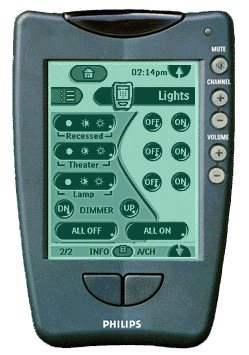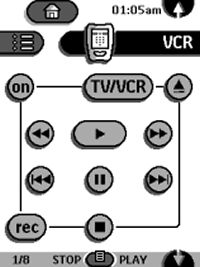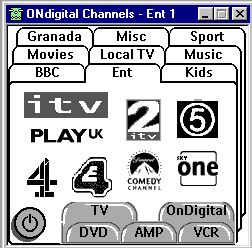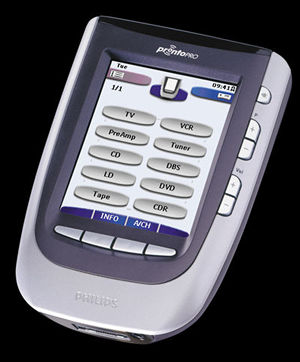Dom Robinson reviews
Model: RU940
Philips
 To get the most out of the Philips Pronto RU940you need to have plenty of remote controls to hand. I have 11 separate ones,which makes this seem ideal, but I don’t sit about with *ALL* eleven neatlyspread around me… since I don’t always use two of them – aDVD-ROMand3dfx Voodoo TVFMcontrol – so only regularly use nine!
To get the most out of the Philips Pronto RU940you need to have plenty of remote controls to hand. I have 11 separate ones,which makes this seem ideal, but I don’t sit about with *ALL* eleven neatlyspread around me… since I don’t always use two of them – aDVD-ROMand3dfx Voodoo TVFMcontrol – so only regularly use nine!
As I write this review, I’ll no doubt be comparing it to theOne For All Mosaicremote control, but while there’s one thing I can think of that it does andthe Philips remote doesn’t, there are plenty of reasons why the Philips scoreshighly over the One For All.
Whereas the Mosaic limited you to controlling a set number of devices, witha set number of standard keys and macro keys and keystrokes, which itself wouldbe limiting because you could still fill those up and still wonder why youhave capacity to spare, that being because after telling the unit whichdevices I wanted to control and configuring extra functions for some of them -and far from the maximum of 72 keys per devices – with 94% of available memoryleft, apparently I had run out of space to program more keys with the ‘learnkeys’ function, I was told by One For All, that they only expected thecustomisation to be used for adding a few functions and clearly not as manyas I was hoping for.
Where the Philips triumphs here, for my purposes at least, is that you reallydo have as much space as you require. The only limit is your imagination, orrather the memory size within, which should well be enough in most cases,depending on the extent of your customisation, but more about that later.

I’ll get my one main niggle out of the way here though. With the Mosaic, Icould easily tell it which devices I wanted to control by searching by brandname or entering a 4-digit code number, which worked for the majority ofAV equipment. As far as I can see, the Pronto doesn’t have this feature, butit was a simple procedure to transfer the commands to the new remote.
Just for the record, the equipment I’m programming in is as follows:a Panasonic 32″ widescreen TV (TXW32R4), a 1982 Ferguson 26″ 4:3 TV, a PhilipsVR747 VCR, a Panasonic NVFJ710 VCR, a Hitachi VTFX880 VCR, a Sony STR-DB 930receiver, a Pioneer CLD-2950 laserdisc player, a Panasonic Sky Digibox and aNokia ITV Digital box.
Not all the functions are replicated, but the though, which is where thelearning function comes in. Simply and easily, it’s a case of pointing theold remote at the bottom end of the Pronto and pressing the buttons as required,in turn, to inform the Pronto of the infra-red (IR) code. Get it right, you’llhear a happy beep. Don’t… and you’ll be burped at.
Once programmed in, keys can be moved about, copied between devices andre-labelled. Labelling uses the same on-screen keyboard layout as the Mosaic,i.e. you see it first quite small, but then tapping on it will zoom in and showthe keys in close-up. Since the brand name selection was done in a similar way,I can only presume there were some rights issues over the missing function.
The accompanying ProntoEdit software is probably the best way forputting together your desired layouts and it’s a doddle to use if you’rewell-versed with a PC. Yes, it may take a bit of figuring out at first, butbeing able to look at-a-glance at any screen within your remote and then toalter it to suit your tastes is fantastic, as is the emulator which, whenyour PC is connected to the remote via the RS232 cable supplied, will activateyour devices as required. This software can be downloaded from the websitesat the bottom of this review.
If you were wondering how to power the Pronto, it takes four AA-sized batteries.To save your Duracells, you could also use NiMH rechargeable ones if you havethose, or purchase a docking station. The batteries must take a bit of apummelling from the backlit display which makes it easy to read at any timeof day, but when not used for twenty seconds, or however long you’ve set thatto be, the touch screen goes blank. Tapping it will bring everything back asit was before.
 The picture on the right shows a standard layout for a VCR’s transport buttons.It may look a bit dull, but we’ll address that in the next section. However,the unit isn’t just limited to single key-presses. The Macro facility is thereto group sets of keys together which, at most, could happily switch on everysingle piece of AV equipment you have, including implementing small delayswhere pieces of equipment are not as responsive as you’d like.
The picture on the right shows a standard layout for a VCR’s transport buttons.It may look a bit dull, but we’ll address that in the next section. However,the unit isn’t just limited to single key-presses. The Macro facility is thereto group sets of keys together which, at most, could happily switch on everysingle piece of AV equipment you have, including implementing small delayswhere pieces of equipment are not as responsive as you’d like.
The ones I use the most, though, are to turn on/off the digibox-generatedsubtitles from both my sources. For the Nokia ITV Digital box, this is justa combination of the “up Christmas tree” and “Text”, with a short delay between(and the buttons are a lot better and more responsive than an ITV Digital remote!),but the Panasonic Sky digital box is far more complicated and is hidden withina couple of menus. However, it only took a few minutes to sort this out andit works a treat.
For those who want to take things further and want to switch on/off theirlights, for those that can be remote-controlled, this is also possible, asis the creation of timers so you can activate your equipment at a specifiedtime when you’re out.
 And so to the customisation feature. The remote comes with a standard set ofkeys built-in, all of which can be tweaked if you have the requisite graphicssoftware and, as I stated earlier, the only limit is your imagination, on thewhole.
And so to the customisation feature. The remote comes with a standard set ofkeys built-in, all of which can be tweaked if you have the requisite graphicssoftware and, as I stated earlier, the only limit is your imagination, on thewhole.
For those of you with the attention span of a goldfish, or for those whosimply can’t be arsed creating works of art and want to see what other peoplehave done, I’d recommend you take a trip toRemote Central.com.I didn’t manage to find every single piece of equipment I have on there, butthere’s a breath-taking amount of control sets for all kinds of AV delightsand you’re bound to find most of what you’re after on there. I looked aroundfor other sites too, but this one came out tops by a long stretch.
Of course, if you have many things to control and go the whole hog withflashy graphics for each one, such as the example here, you will run out ofmemory, so you may need to be conservative with some of your hardware.
 Before I sign off, I’ll give a mention to the Pronto Pro (codenamedRU970), essentially the bigger brother of the unit reviewed here, but you’llneed to be a very dedicated user of home cinema to afford one of these.
Before I sign off, I’ll give a mention to the Pronto Pro (codenamedRU970), essentially the bigger brother of the unit reviewed here, but you’llneed to be a very dedicated user of home cinema to afford one of these.
A whacking £750 will get you this similar remote, but with a full256-colour screen, a larger 8MB memory and four customisable buttons at thebottom instead of just two.
A tilt sensor realises when you pick it up and backlights accordingly, there’smore codes pre-programmed into it than any previously-released unit andit’s just as programmable as the rest, with scores of control sets alsoavailable on the aforementioned Remote Central.comwebsite.
It’s, quite definitely, the daddy! But you’ll also need to raid his walletin order to buy one!
Overall, I’ll shed a tear when the Pronto 2MB wings its way back to Philipsbut it’s well worth a purchase. The only major issues I have is with thebrand name inputting – or rather the lack of it – and the fact I can’t programthe timers for my Hitachi and Philips VCRs, as it can’t mimic events of keystrokeswhere the ‘action’ takes place on the remote only. The unit is an incrediblyversatile one so I imagine it is possible, but it may be something that themanufacturers want to keep to themselves, which is a shame if that’s the case.
Of course, a minor annoyance is that I find myself spending more timelooking down at the remote than you would with the individual remotes inquestion because you don’t get the same ergonomic feel. I expected this inthe first place so haven’t marked it down as a result.





Or ring the customer hotline on: 0870 900 9070
Review copyright © Dominic Robinson, 2002.
Reviewer of movies, videogames and music since 1994. Aortic valve operation survivor from the same year. Running DVDfever.co.uk since 2000. Nobel Peace Prize winner 2021.
